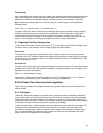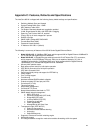39
6.2.2 Flow Control
With a link operating at a high data rate, a switch may experience occasional limitations in the buffer space
used to store Ethernet frames before forwarding them. In this situation, if the sending station continues to
send frames, the switch will have no option but to discard the frames. This may quickly lead to unacceptable
delays in upper-level protocols.
In order to avoid unnecessarily dropping frames, a switch may implement Flow Control. Flow control is a
feature that allows the switch to recognize when the buffer space is limited, and to send an Ethernet PAUSE
frame to its link partner to cease transmission for a specified period. As with a full duplex link, both ends of
the link must understand flow control for the mechanism to operate properly.
6.2.3 Auto-Negotiation
As discussed above, you need to make sure that both ends of a link agree about the duplex and flow control
settings to be used (as well as the speed of the connection). In even a mid-sized network, making sure that
all the links agree on all these parameters would be too big a job if the network manager had to configure
every connection manually.
To make configuration as automatic as possible, the IEEE has defined standards so that most connections
can be automatically configured by the hardware, without manual intervention. Devices can agree on the
speed, duplex mode and flow control settings for each individual connection. The possible links states are
ranked:
1000Mbps/Full Duplex
1000Mbps/Half Duplex (never used)
100Mbps/Full Duplex
100Mbps/Half Duplex
10Mbps/Full Duplex
10Mbps/Half Duplex
With auto-negotiation, the link partners will configure the link to operate at the highest speed and duplex
state that both support.
Auto-negotiation is supported on IntraCore switches on all UTP ports. GBIC ports operate at 1Gbps only,
and only in full duplex mode, so auto-negotiation is disabled for GBIC ports.
Note: If an Ethernet device that is capable of auto-negotiation is connected to a port that has auto-
negotiation turned off, the auto-negotiating device will default to half duplex mode. If the port that is not using
auto-negotiation is set to full duplex, the link will have a duplex mismatch, and will so slow that it may be
unusable. If you configure an Ethernet port to operate in full duplex mode, you must also configure the link
partner to operate in full duplex. It is almost always better to let auto-negotiation take care of this for you.


















